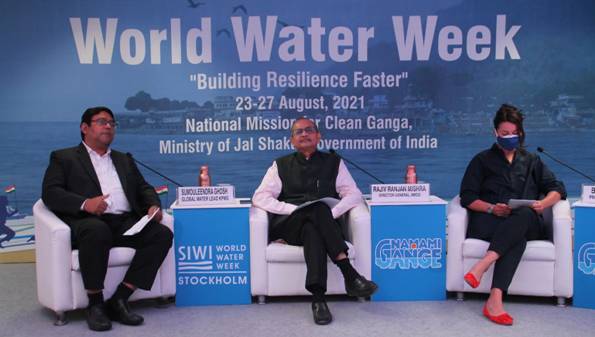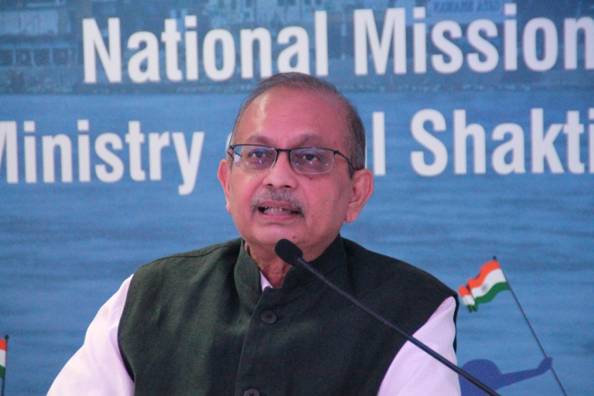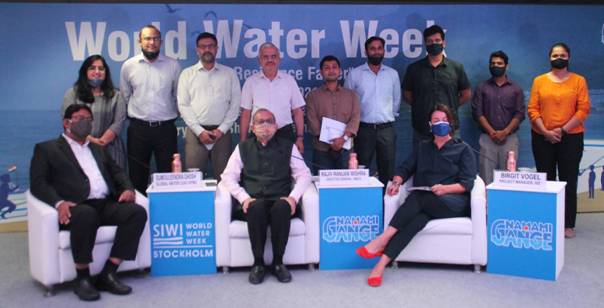Ministry of Jal Shakti
NMCG hosts Session on ‘Zero Liquid Discharge Cities’ on Day 4 of Stockholm World Water Week 2021
प्रविष्टि तिथि:
26 AUG 2021 7:20PM by PIB Delhi
National Mission for Clean Ganga hosted the third Meet & Mingle session on ‘Zero Liquid Discharge Cities’ on the Final Day of the Stockholm World Water Week 2021. Mr. Sumouleendra Ghosh, Global Water Lead of KPMG moderated the session. He welcomed everyone and introduced NMCG as an integrated mission focusing on rejuvenation, protection, and restoration of the Ganga River Basin, one of the largest river basins across the globe. To set the context of the session, he explained that Zero Liquid Discharge (ZLD) is a well-known concept but currently associated with industries. However, it is time to extend ZLD concept to Indian cities as well. We all are aware of climate change manifesting its threats through water related issues in the form of floods, inundation, sea level rise or droughts. Many Indian and global cities are already facing threats of acute water security and to manage and mitigate the risk we need to emphasize on recycle and reuse of treated wastewater. He closed his remarks by saying that just like Net Zero in carbon emissions, the concept of ZLD is an aspiration in this journey to increase reuse of treated wastewater and the session will cover the issues of treated wastewater reuse in cities.

He invited Mr. Rajiv Ranjan Mishra, Director General, NMCG to discuss implementation challenges and policy interventions with reuse of treated wastewater and touch upon work done within NMCG in collaboration with industries and ministries. Mr. Mishra said that this is an aspirational topic and industries are already being mobilized to achieve it, but cities need to concentrate their focus to achieve ZLD. The Ganga basin is one of the most important and unique basins in India and NMCG has been taking crucial steps to operationalize IRBM and Urban River Management Plan for making the river healthy. “We need to focus on overall water cycle including the ecological and economical need and nothing should be wasted”, he said and that,” We should not let out wastewater in the rivers and should consider naming this water differently based on its functionality for recycle and reuse.

The DG, NMCG emphasized a focus on developing policies and other operational interventions to achieve ZLD at city level. He shared that NMCG in collaboration with GIZ India has developed a national level framework for reuse of treated wastewater in India. He mentioned that Mathura Refinery project is a good example of wastewater reuse initiative of NMCG by collaborating with industries. He concluded that we need to on association with power, agriculture and other sectors, collaboration with academic institutions to provide research solutions and administrative support in regulatory and operational aspects. He welcomed all speakers to provide suggestions to move forward in this area.
Mr. Sumouleendra Ghosh thanked Mr. Mishra for sharing his thoughts on the policy aspects and highlighting the excellent work being done in this area by many arms of the Government. He said that government initiatives should be complemented by private sector participation which should either he driven by regulations or through market linked incentive systems. He briefly talked about one such model being conceptualised by WRG2030. The model is a wastewater reuse certificate trading system which is a market-based cap and trade system. KPMG India is closely working with WRG2030 in operationalizing the concept. The trading certificate system is decided based on water budget allocation and has components of penalty and extra credit points for over achievers. This has been piloted in India and will be scaled at global level. He concluded by saying that there is need to create overarching framework required where this national level framework comes in.
Mr. Jeremy Bird, GIZ India was invited by Mr. Ghosh to elaborate on the National Water Reuse Framework (NWRF) for India. He talked about the European structure having similar issue as observed in India and other parts of the world. He highlighted that countries are using the treated water for different purposes such as industrial use, recreational activities and so on. He pointed out that we need to incentivize the whole concept to push for implementation at a larger scale. Talking about associated challenges, he mentioned overall cost issues, transport costs, matching demand and supply from quantity and quality perspective. Hence, we need to develop a combination of models including both public and private players to implement ZLD in cities context. He said that NWRF is developed on similar concepts and will reduce the pressure on natural resources. Agreeing to thoughts shared by Mr. Jeremy, Ms. Birgit Vogel, GIZ India also supported the development and implementation of NWRF to solve the larger problem of water scarcity in India.
Mr. Ghosh then invited Mr. BanchhanidhiPani, Municipal Commissioner, Surat Municipal Corporation to explain Surat city’s case of treated wastewater reuse. He informed that Surat city is receiving water from the Tapi river and the water consumption of Surat city is 1200 MLD. In 2014, the tertiary treatment plant was initiated to cater to the water demand of industries. This was initially started as a demand-based approach and 35 MLD treated wastewater was made available but today the demand reached 115 MLD for industries. He also highlighted that this model has proved economically beneficial as they are receiving 140 crores which is above operational and maintenance costs of all existing STPs. He said that though this is mainly for industries it is also used for landscape, construction and recreational purposes and out of 950 MLD, more than 30% of wastewater is reused. SMC is planning to achieve 50% by 2025 and 100% by 2030 to achieve the aim of ZLD. He shared that various missions and schemes were converged to achieve these targets including SBM (Urban), AMRUT, 15th Finance Commission. He concluded by informing that a new scheme has been rolled out where untreated sewerage will be provided to industries for treating it at their end and this will reduce the CAPEX costs. The SMC has succeeded in making ZLD a roadmap rather than being an aspirational concept.

Following the implementation part, Dr. Nupur Bahadur, TERI was invited to share her thoughts on importance of research and development through the Center of Excellence. Dr. Nupur talked about how all the stakeholders have been mobilized and are working towards implementing ZLD at city level. She suggested that research and innovation are the two important components of National Water Reuse Framework and the advanced oxidation technology by TERI should help achieve ZLD in an economical manner. The technology is developed to build the infrastructure capacity and the idea behind the Center of Excellence is to achieve SDG and optimize waste reuse potential by supporting this at a larger scale in the country.
Following this, Mr. Arun Lakhani, Chairman, Vishwaraj Group was asked to share his thoughts. He talked about the need to revive the municipal infrastructure to achieve circular sustainable economy. In Nagpur this is done in full circle where NRW is reduced as the first step along with onboarding of private players as the provision of 24X7 water supply and management of demand side is a big challenge. We need investment to treat sewerage system as currently one-third of the generated wastewater is treated. He said that it is important to replace the freshwater with treated reuse water for all the non-potable uses in industries. In Nagpur, PPP model has been implemented wherein 200 MLD of wastewater is treated and 190 MLD treated water is given to thermal power plant. He informed that thermal power plant itself has a 110 MLD wastewater treatment plant. Nagpur is generating close to 600 MLD and more than 300 MLD is being treated currently. We need to also focus on agricultural use as we need to focus on the pricing part and central government should support differential cost of treated water and policy price.
Mr. Rajneesh Chopra, Global Head VA Tech Wabag Ltd. talked about the case of Chennai city which has been water stressed city in the last few years. Chennai is currently generating 727 MLD secondary treated water, out of this 110 MLD has been treated and supplied to industries. He emphasized on the fact that for all the cities the industrial clusters and customers are not available, and we need to have standards for other uses as well. Talking about the case of Tehran he explained how treated wastewater was channelized to supply for various uses such as power generation, irrigation which is further leading to agricultural benefits. He said that by adopting these strategies everything is consumed. Chennai has plans to treat 550 MLD to recharge groundwater which will be used for potable uses as well.
B K Agarwal, CEO Triveni Engineering & Industries Ltd was invited to elaborate on Mathura Refinery with which NMCG is also involved. He said that in Mathura, UP the treated wastewater was provided to Indian Oil Refinery. Other than this they are treating wastewater for textile industries and conducting research for in-situ treatments. He suggested to pilot projects in cities or districts experiencing overexploitation of water and approach with water scarcity problem. He also suggested to implement tariff-based approach for over exploitation of water in cities or districts.
Lastly, Prof. Vinod Tare, IIT Kanpur mentioned that GRBMP has also mentioned the concept of ZLD in the context of River Ganga. He primarily suggested to reuse treated wastewater on the basis of geographic locations. He also mentioned that it is important to have situation and area specific standards for reuse purposes. In the end, Mr. Sumouleendra Ghosh and Mr Mishra thanked all the speakers and participants for making the session insightful and successful.
**********
BY/AS
(रिलीज़ आईडी: 1749317)
आगंतुक पटल : 2430